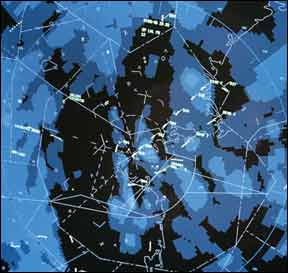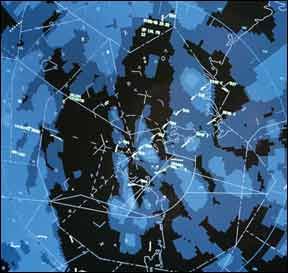November 12345, turn right, heading 140, vector around traffic.” So begins yet another excursion off our planned course, courtesy of ATC: a vector. In their primary role-helping prevent us from swapping paint with each other-controllers use vectors to maintain spacing or establish sequencing for a runway. Other reasons for a vector include helping keep us out of weather or airspace, or because we request it. In fact, ATC always is supposed to tell us why were being vectored, something well get to in a moment. 288 The reality in todays go-direct-everywhere ATC system usually means a heading to fly is not something we want or appreciate, since its usually an off-course delay, lengthening our trip and wasting time and fuel. But there are times-in terminal airspace especially, or when circumnavigating special-use airspace while en route-when vectors are good things and can help us cut various corners. Regardless of whether we love or loathe the vector we just received, there are some rules and procedures behind them we should understand to ensure we know whats going on, to ensure ATC doesnt forget about us and to ensure well eventually get back on course. What is A Vector, Anyway? At its most basic, a vector is simply a heading to fly. The FAAs Pilot/Controller Glossary (P/CG) uses the ICAO phrase “radar vectoring” and defines it as “provision of navigational guidance to aircraft in the form of specific headings, based on the use of radar.” Thats a pretty good description of a vectors practical application, but leaves out a lot of detail. For example, under what circumstances can ATC provide a vector? Pretty much any time a controller wants is the quick answer. Both the Aeronautical Information Manual (AIM) and FAA Order JO 7110.65T, Air Traffic Control, say basically this: ATC can vector flights in controlled airspace “for separation, safety, noise abatement, operational advantage, or when a pilot requests.” As one might imagine, some other parameters apply. One of the most important is altitude. Generally, an IFR aircraft cannot be vectored at an altitude beneath the areas minimum vectoring altitude, or MVA. The MVA is usually a mystery to pilots and is based on a complex set of variables including terrain, obstructions and distance/geometry relative to the radar antenna. Generally, an MVA applies in terminal airspace and is determined by the local tracon. When in the en route environment, the minimum IFR altitude (MIA) is what an ARTCC has to work with, examples of which are MEA, MOCA, etc. According to the P/CG, the MIA also is determined as 2000 feet above the highest obstacle within four nm from the course to be flown when in a designated mountainous area, 1000 feet above any obstacle within four nm elsewhere, or as otherwise authorized. There are occasions when the MVA doesnt apply, or a flight can be vectored beneath it. They basically involve departures or missed approaches where the aircraft is below the MVA but climbing to an altitude at least 1000 feet above the controlling obstruction and is at least three nm from it. The foregoing discussion of MVAs and MIAs applies to IFR aircraft; what about when were operating VFR? In those instances, the MVA/MIA dont matter because the VFR pilot is responsible for his or her own terrain and obstacle avoidance. However, theres a practical minimum altitude here, also, and thats the radar systems ability to “see” you at a specific altitude. Of course, vectoring is only done in a radar environment. Thats a good thing, because the standard vector doesnt always include information on when, where or under what circumstances the vector will end. Terminal Vectors Perhaps the most common vector with which instrument-rated pilots are familiar is to join a final approach course or toward an en route fix. This type of vector usually is much appreciated by the pilot as it eliminates the need to perform the full, published arrival or departure procedure. It helps us get on our way when departing and usually eliminates the need for a course reversal, if necessary, when arriving. Basically, it allows us to cut a few corners. But, and as with any other vector, certain rules apply. Among them is the requirement for ATC to tell us were being vectored to the join the final approach course, or when were going to cross that final approach course, for whatever reason, with the expectation well get a follow-up vector to get us back to the final. These bits of information might seem to be a no-brainer when sitting in an armchair, but more than one pilot experiencing a high-workload situation has done the wrong thing and joined the final-or flown right through it-despite a controllers best intentions. The controller also must advise which approach were being vectored for, if it isnt already obvious, and state an altitude to maintain under certain conditions. Those conditions include when the vector will take the aircraft off a previously assigned procedure with altitude instructions. Examples include an approach procedure, arrival or departure, or when a previous clearance included crossing restrictions. In this latter instance-usually involving an arrival or departure procedure-ATC should be telling us what to expect, like rejoining the previously issued routing. The most-typical vector in a terminal environment, however, is the one to join a final approach course. That vector will include the heading to fly, an altitude to maintain until established on the inbound course and what to do upon reaching it. Vector Clearances Each instruction to fly a vector issued by ATC must include certain basic information. This is true for VFR and IFR flights. That said, weve seen several instances over the years when a controller omitted some of the information required to be in the vector clearance. Each time, weve asked for the missing information-which is usually the reason for the vector-and most of the time the response includes the necessary information. Examples include a heading to fly to intercept an airway or radial, for spacing behind slower traffic or for the aforementioned final approach course. The most basic thing a vector must include is a direction. That can be a different heading, it can be your present heading or it can be a specified number of degrees left or right of your present heading. One exception is when receiving no-gyro vectors, either for practice or after some or all of your panels primary flight instrumentation has failed. In that event, ATC states, “This will be a no-gyro vector,” tells you in which direction to turn and when to stop the turn. A vector also can be given for the future, as when meeting stated criteria. An example might be to fly a certain heading upon departing a specified fix, or when arriving at/passing through an altitude. The vector ends when we reach the navaid, fix or published route to which weve been sent, or when ATC gives us another one. Finally, dont forget we can request vectors to avoid weather, for example, or around unseen traffic. Theyll be given as conditions allow. Vectors are necessary in a radar environment and can be a pain, but they also can save us time and money, especially when we want to go direct to some distant point but dont have the nav gear to do it. Asking ATC for a vector to our destination, while adding something to the effect of “Well monitor with a handheld GPS” got it done before panel-mounted GPS became the rage. Thankfully, we can still get those vectors today.




